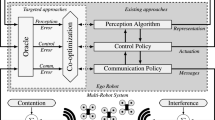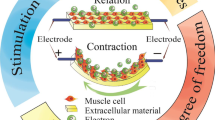Abstract
In self-assembly tasks, local interactions between robotic structure parts induce a collective behaviour that guides the robots to assume a desired shape. In this work, we propose a self-assembly strategy for building three-dimensional structures using robotic blocks. The assembly is executed layer-by-layer, and each layer grows from a single position called seed position. The robots follow a set of pre-programmed behaviours to perform the assembly task. Moreover, each robot is only capable of local sensing and empty positions in the structure are not known a priori. Robots carry a blueprint of the structure, containing relative coordinates for where blocks should be placed. A graph is extrapolated from the blueprint and used to define the structural properties necessary to analyze correctness and efficiency of the proposed technique. Simulated results show that the distance that robots travelled during assembly is likely to be the shortest path possible. Also, graph-based metrics are applied to evaluate the selection of different seed positions, drawing a relationship between structure blueprint and the distance travelled by the robots. Finally, physical experiments demonstrate the applicability of the proposed algorithms in realistic scenarios.
Similar content being viewed by others
References
Cabral, K.M., Givigi, S.N., Santos, D.S.R.B., Jardine, P.T.: Design of a self-assembly system of three-dimensional structures using autonomous construction blocks. In: 2019 IEEE International Systems Conference (Syscon), pp. 1–8 (2019), https://doi.org/10.1109/SYSCON.2019.8836938
Klavins, E.: Programmable self-assembly. IEEE Control. Syst. Mag. 27(4), 43–56 (2007). https://doi.org/10.1109/MCS.2007.384126
Rubenstein, M., Cornejo, A., Nagpal, R.: Programmable self-assembly in a thousand-robot swarm. Science 345(6198), 795–799 (2014). https://doi.org/10.1126/science.1254295
Gauci, M., Nagpal, R., Rubenstein, M.: . In: Groß, R., Kolling, A., Berman, S., Frazzoli, E., Martinoli, A., Matsuno, F., Gauci, M. (eds.) Programmable Self-disassembly for Shape Formation in Large-Scale Robot Collectives, pp 573–586. Springer, Cham (2018), https://doi.org/10.1007/978-3-319-73008-0_40
Medellin, H., Corney, J.R., Davies, J.B.C., Lim, T., Ritchie, J.M.: Octree-based production of near net shape components. IEEE Trans. Autom. Sci. Eng. 5(3), 457–466 (2008). https://doi.org/10.1109/TASE.2007.912059
Werfel, J., Nagpal, R.: Three-dimensional construction with mobile robots and modular blocks. Int. J. Robot. Res. 27(3-4), 463–479 (2008)
Magueta, M.P.B., Santos, S.R.B.D., Cappabianco, F.A.M., Givigi, S.N.: Designing collective behavior for construction of containment structures using actuated blocks. In: 2020 IEEE International Systems Conference (Syscon), pp. 1–8 (2020), https://doi.org/10.1109/SysCon47679.2020.9275866
Szwaykowska, K., Romero, L.M.-Y.-T., Schwartz, I.B.: Collective motions of heterogeneous swarms. IEEE Trans. Autom. Sci. Eng. 12(3), 810–818 (2015). https://doi.org/10.1109/TASE.2015.2403253
Paulos, J., Eckenstein, N., Tosun, T., Seo, J., Davey, J., Greco, J., Kumar, V., Yim, M.: Automated self-assembly of large maritime structures by a team of robotic boats. IEEE Trans. Autom. Sci. Eng. 12(3), 958–968 (2015). https://doi.org/10.1109/TASE.2015.2416678 . Accessed 21 Oct 2018
Petersen, K.H., Napp, N., Stuart-Smith, R., Rus, D., Kovac, M.: A review of collective robotic construction. Sci. Robot. 4(28), 8479 (2019)
Lindsey, Q., Mellinger, D., Kumar, V.: Construction with quadrotor teams. Auton. Robot. 33(3), 323–336 (2012). https://doi.org/10.1007/s10514-012-9305-0. Accessed 09 Oct 2018
Willmann, J., Augugliaro, F., Cadalbert, T., D’Andrea, R., Gramazio, F., Kohler, M.: Aerial robotic construction towards a new field of architectural research. Int. J. Architect. Comput. 10(3), 439–459 (2012). https://doi.org/10.1260/1478-0771.10.3.439. Accessed 21 Oct 2018
Augugliaro, F., Lupashin, S., Hamer, M., Male, C., Hehn, M., Mueller, M.W., Willmann, J.S., Gramazio, F., Kohler, M., D’Andrea, R.: The flight assembled architecture installation: Cooperative construction with flying machines. IEEE Control. Syst. Mag. 34(4), 46–64 (2014). https://doi.org/10.1109/MCS.2014.2320359
Barros dos Santos, S.R., Givigi, S., Nascimento, C.L., Fernandes, J.M., Buonocore, L., de Almeida Neto, A.: Iterative decentralized planning for collective construction tasks with quadrotors. J. Intell. Robot. Syst. 90(1), 217–234 (2018). https://doi.org/10.1007/s10846-017-0659-6
Alejo, D., Cobano, J.A., Heredia, G., Ollero, A.: Collision-free 4d trajectory planning in unmanned aerial vehicles for assembly and structure construction. J. Intell. Robot. Syst. 73(1), 783–795 (2014)
Nottensteiner, K., Sachtler, A., Albu-Schäffer, A.: Towards autonomous robotic assembly: Using combined visual and tactile sensing for adaptive task execution. J. Intell. Robot. Syst. 101(3), 1–22 (2021)
Magnenat, S., Philippsen, R., Mondada, F.: Autonomous construction using scarce resources in unknown environments. Auton. Robot. 33(4), 467–485 (2012). https://doi.org/10.1007/s10514-012-9296-x
Barros dos Santos, S.R., Dantas, D.O., Givigi, S.N., Buonocore, L., Neto, A.A., Nascimento, C.L.: A stochastic learning approach for construction of brick structures with a ground robot. IFAC-PapersOnLine 50(1), 5654–5659 (2017). https://doi.org/10.1016/j.ifacol.2017.08.1114 . 20th IFAC World Congress
Zhang, Y., Koga, Y., Balkcom, D.: Interlocking block assembly with robots. IEEE Trans. Autom. Sci. Eng. 18(3), 902–916 (2021). https://doi.org/10.1109/TASE.2021.3069742
dos Santos, S.R.B., Givigi, S.N., Nascimento, C.L.: Autonomous construction of multiple structures using learning automata: Description and experimental validation. IEEE Syst. J. 9(4), 1376–1387 (2015)
Santos, S.R.B.D., Júnior, C.L.N., Givigi, S.N.: Planning and learning for cooperative construction task with quadrotors. In: 2014 IEEE International Systems Conference Proceedings, pp. 57–64 (2014), https://doi.org/10.1109/SysCon.2014.6819236
Cabral, K.M., Givigi, S.N., Jardine, P.T.: Autonomous assembly of structures using pinning control and formation algorithms. In: 2020 IEEE International Systems Conference (Syscon), pp. 1–7 (2020), https://doi.org/10.1109/SysCon47679.2020.9275901
Zeravcic, Z., Brenner, M.P.: Spontaneous emergence of catalytic cycles with colloidal spheres. Proc. Natl. Acad. Sci. 114(17), 4342–4347 (2017). https://www.pnas.org/content/114/17/4342.full.pdf. https://doi.org/10.1073/pnas.1611959114
Hormoz, S., Brenner, M.P.: Design principles for self-assembly with short-range interactions. Proc. Natl. Acad. Sci. 108(13), 5193–5198 (2011)
Li, H., Wang, T., Wei, H., Meng, C.: Response strategy to environmental cues for modular robots with self-assembly from swarm to articulated robots. J. Intell. Robot. Syst. 81(3), 359–376 (2016)
Ahmadzadeh, H., Masehian, E., Asadpour, M.: Modular robotic systems: Characteristics and applications. J. Intell. Robot. Syst. 81(3), 317–357 (2016)
Fu, J., Lv, Y., Wen, G., Yu, X.: Local measurement based formation navigation of nonholonomic robots with globally bounded inputs and collision avoidance. IEEE Trans. Netw. Sci. Eng. 8(3), 2342–2354 (2021). https://doi.org/10.1109/TNSE.2021.3089833
Coppola, M., Guo, J., Gill, E., de Croon, G.C.: Provable self-organizing pattern formation by a swarm of robots with limited knowledge. Swarm Intell. 13(1), 59–94 (2019)
Li, H., Wang, T., Chirikjian, G.S.: Self-assembly planning of a shape by regular modular robots. In: Advances in Reconfigurable Mechanisms and Robots II, pp. 867–877. Springer (2016)
Dutta, A., Dasgupta, P., Nelson, C.: Distributed configuration formation with modular robots using (sub) graph isomorphism-based approach. Auton. Robot. 43(4), 837–857 (2019)
Thangavelu, V., Liu, Y., Saboia, M., Napp, N.: Dry stacking for automated construction with irregular objects. In: 2018 IEEE International Conference on Robotics and Automation (ICRA), pp 4782–4789. IEEE (2018)
Yue, Z., Lian, B., Tang, C., Tong, K.: A novel adaptive federated filter for GNSS/INS/VO integrated navigation system. Meas. Sci. Technol. 31(8), 085102 (2020). https://doi.org/10.1088/1361-6501/ab78c2
Wang, D., O’Keefe, K., Petovello, M.: Decentralized cooperative positioning for vehicle-to-vehicle (v2v) application using gps integrated with uwb range. In: Proceedings of the ION 2013 Pacific PNT Meeting, pp. 793–803 (2013)
Gómez-Casasola, A., Rodríguez-Cortés, H.: Sensor fusion for quadrotor autonomous navigation. In: 2020 American Control Conference (ACC), pp. 5219–5224. IEEE (2020)
Seo, J., Yim, M., Kumar, V.: Assembly planning for planar structures of a brick wall pattern with rectangular modular robots. In: 2013 IEEE International Conference on Automation Science and Engineering (CASE), pp. 1016–1021. IEEE. https://doi.org/10.1109/CoASE.2013.6653996. Accessed 20 Oct 2018 (2013)
Cormen, T.H., Leiserson, C.E., Rivest, R.L., Stein, C.: Introduction to Algorithms. MIT Press, Cambridge (2009)
Hales, T.C.: The Jordan curve theorem, formally and informally. Am. Math. Mon. 114(10), 882–894 (2007)
Nozari, E., Pasqualetti, F., Cortés, J.: Heterogeneity of central nodes explains the benefits of time-varying control scheduling in complex dynamical networks. Journal of Complex Networks. https://doi.org/10.1093/comnet/cnz001 (2019)
Pasqualetti, F., Zampieri, S., Bullo, F.: Controllability metrics, limitations and algorithms for complex networks. IEEE Trans. Control Netw. Syst. 1(1), 40–52 (2014). https://doi.org/10.1109/TCNS.2014.2310254
Cortesi, F.L., Summers, T.H., Lygeros, J.: Submodularity of energy related controllability metrics. In: 53rd IEEE Conference on Decision and Control, pp. 2883–2888. IEEE (2014)
Saldana, D., Gabrich, B., Li, G., Yim, M., Kumar, V.: Modquad: The flying modular structure that self-assembles in midair. In: 2018 IEEE International Conference on Robotics and Automation (ICRA), pp. 691–698. IEEE (2018)
Silano, G., Aucone, E., Iannelli, L.: Crazys: A software-in-the-loop platform for the Crazyflie 2.0 Nano-Quadcopter. In: 2018 26Th Mediterranean Conference on Control and Automation (MED), pp. 1–6 (2018), https://doi.org/10.1109/MED.2018.8442759
Baker, S., Matthews, I.: Lucas-kanade 20 years on: a unifying framework. Int. J. Comput. Vision 56(3), 221–255 (2004)
Funding
This work was supported in part by the Natural Sciences and Engineering Research Council (NSERC) of Canada through a grant held by Dr. Sidney Givigi under the Discovery Grant Program.
Author information
Authors and Affiliations
Contributions
All authors contributed to the work conception and design. Material preparation and data collection were performed by Dr. Kléber Cabral and Dr. Jean-Alexis Delamer. Analysis and proofs were performed by Dr. Kléber Cabral, Mr. Tanvir Kaykobad, Dr. Jardine and Dr. Givigi. The first draft of the manuscript was written by Dr. Kléber Cabral and all authors commented on previous versions of the manuscript. All authors read and approved the final manuscript.
Corresponding author
Ethics declarations
Ethics approval
Not applicable
Consent to participate
Not applicable
Consent to publish
Not applicable
Conflict of Interests
Dr. Cabral, Mr. Kaykobad, Dr. Delamer, Dr. Jardine, and Dr. Givigi declare they have no financial interests.
Additional information
Publisher’s Note
Springer Nature remains neutral with regard to jurisdictional claims in published maps and institutional affiliations.
Rights and permissions
Springer Nature or its licensor (e.g. a society or other partner) holds exclusive rights to this article under a publishing agreement with the author(s) or other rightsholder(s); author self-archiving of the accepted manuscript version of this article is solely governed by the terms of such publishing agreement and applicable law.
About this article
Cite this article
Cabral, K., Kaykobad, T., Delamer, JA. et al. Design of a Decentralized Strategy for Layered Self-Assembly of 3D Structures Using Robotic Blocks. J Intell Robot Syst 107, 54 (2023). https://doi.org/10.1007/s10846-023-01825-2
Received:
Accepted:
Published:
DOI: https://doi.org/10.1007/s10846-023-01825-2




